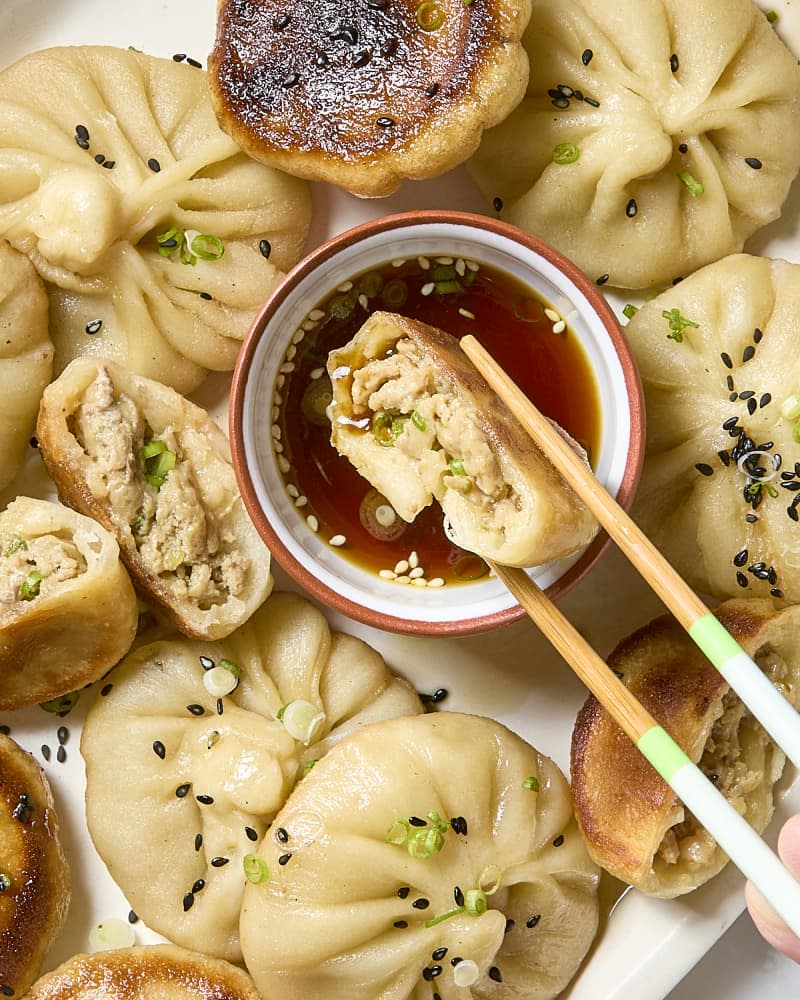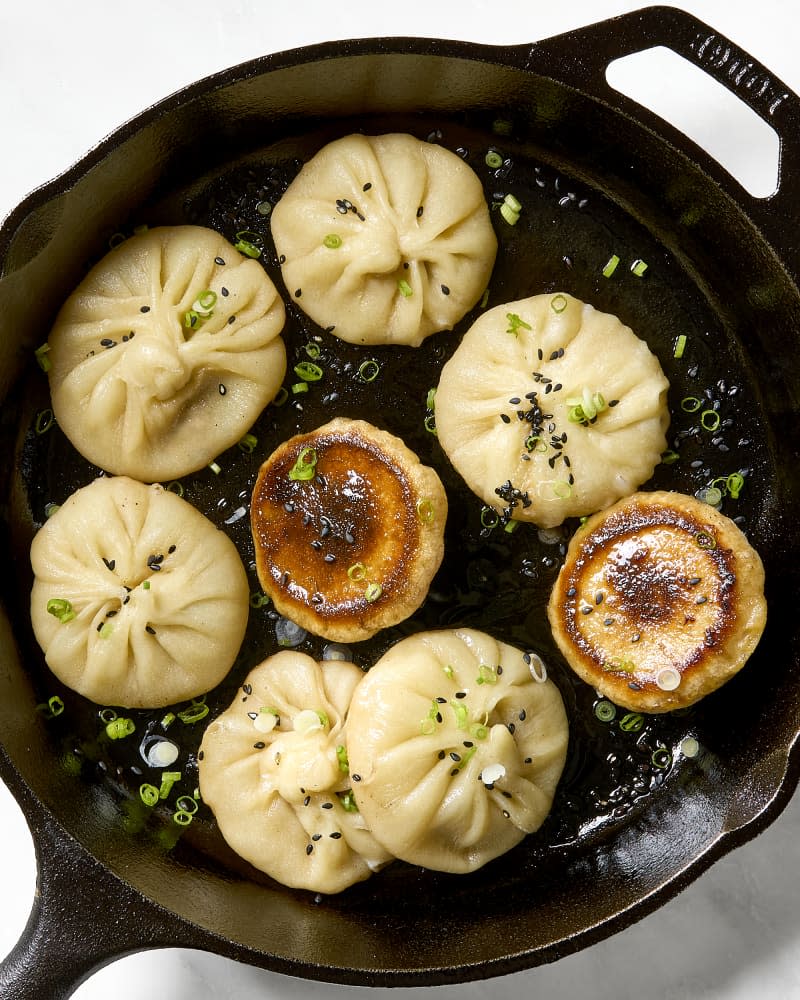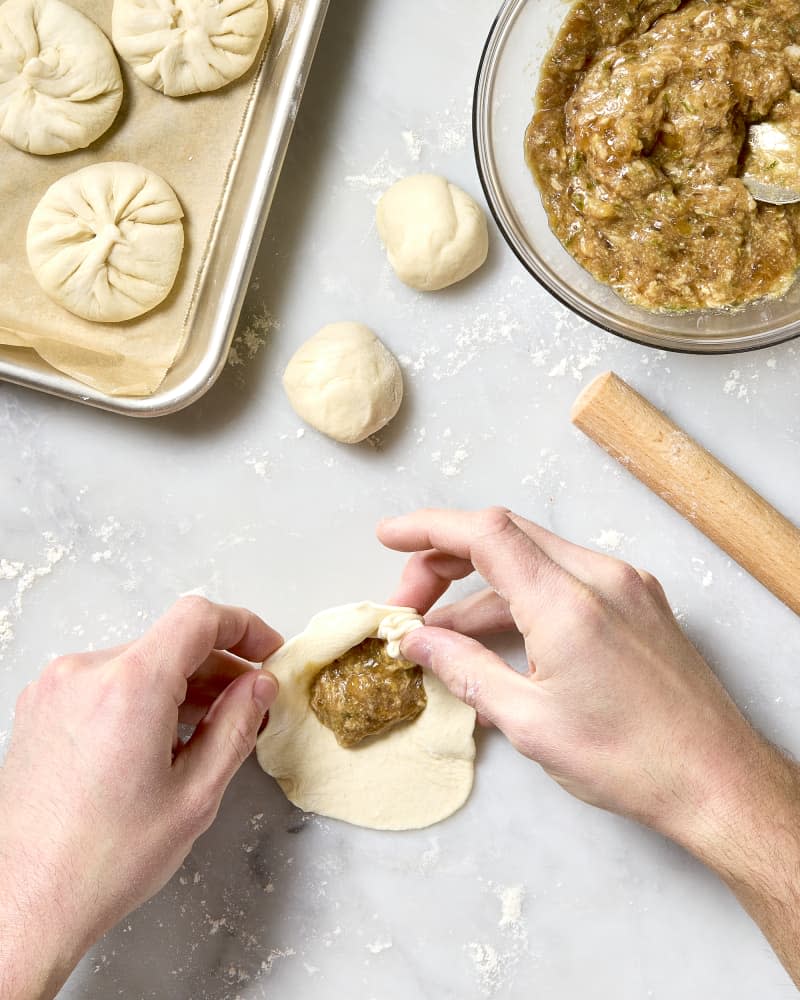These Crispy Pan-Fried Dumplings Will Transport You Straight to Shanghai

Sheng jian bao (pan-fried pork buns) don’t get enough love. The cousin to the more popular xiao long bao (soup dumplings), sheng jian bao hail from Shanghai, where they’re typically enjoyed as breakfast, lunch, and street food. With their tender pork filling, savory hot soup, and slightly thicker, fluffy wrapper that’s complete with crispy golden bottoms, these pan-fried pork buns are ready for their turn in the spotlight.
In this recipe, I’ll walk you through how to make (and pleat!) your own restaurant-worthy sheng jian bao at home. Don’t fret if your pleats aren’t perfect the first time around. Because the pork buns are traditionally cooked with the pleat-side down, as long as they’re well-sealed, that’s all you need. (And, according to the recipe tester, even the badly pleated ones are good!) Once you get the hang of it, switch to cooking pleat-side up to show off your skills.

Key Ingredients in Sheng Jian Bao
There are other varieties of sheng jian bao that include mushrooms or napa cabbage (here’s a handy guide to the different types of cabbage), but this recipe does without those ingredients to deliver the purest pork flavor.
Ground pork: Pork is traditional in the filling, but you can substitute ground chicken instead. Just make sure to use ground dark chicken meat.
Powdered gelatin. Traditionally sheng jian bao have a filling made with pork aspic (a gelatin made from pork skin and aromatics like scallions and ginger) and ground pork seasoned with soy sauce, ginger, and scallions. Here, I use a combination of powdered gelatin and chicken stock, which delivers the same juicy effect (similar to soup dumplings).
Chicken broth. I recommend low-sodium or unsalted chicken stock so you can control the salt level. If you can find it, try subbing pork stock.
Chinese black vinegar or Chinkiang vinegar. Used as a dipping sauce to provide a tang and to balance the savory flavors of the pork buns. If you prefer a lighter tangy flavor, you can use a 50:50 mixture of soy sauce and Chinese black vinegar.
How to Make Sheng Jian Bao
Make the jellied chicken stock and filling. Bloom gelatin with a bit of chicken stock, melt to dissolve the gelatin over low heat, and whisk in the remaining stock. Then, chill until firm. Blend the seasonings in a food processor, then add ground pork and chopped jellied chicken stock, and pulse to combine.
Make the dough. Dissolve yeast in warm water, add the rest of the dry ingredients, and knead the dough until smooth. Let proof until it nearly doubles in volume.
Assemble the buns. Divide the dough into 24 equal pieces, fill with a heaping tablespoon of pork filling, and pleat. Fry in a large skillet (your choice of pleat-side up or down) until golden on the bottom. Add cold water, cover, and steam the buns. Serve crispy-side up and enjoy piping hot — just be careful of the hot soup on the inside!

If You’re Making Sheng Jian Bao, a Few Tips
Pulse, pulse, pulse. Don’t be afraid to pulse the ground pork mixture until there are streaks of sticky pork. This contributes to their tender texture.
Practice your pleats. Mastering the pleats takes a lot of practice. Don’t stress over making them pretty; it’s more important that the buns are well-sealed. It can be as easy as gathering the edges together and pinching them closed.
Keep the cooking spray handy. Nonstick cooking spray isn’t traditional, but it guarantees that the cooked pork buns slide right out of the pan.
Sheng Jian Bao (Pan-Fried Pork Buns) Recipe
You can make your own Chinese restaurant-worthy pork buns at home.
Prep time 2 hours to 3 hours
Cook time 50 minutes to 55 minutes
Makes 24 (2.5-inch) buns
Ingredients
For jellied chicken stock and filling:
1 cup unsalted chicken stock or low-sodium chicken broth
1 (1.4-ounce) envelope unflavored powdered gelatin (2 1/2 teaspoons)
3 medium scallions
1 (1-inch) piece ginger
1/4 cup Shaoxing wine
1/4 cup cold water
1 tablespoon plus 1 1/2 teaspoons soy sauce
2 teaspoons granulated sugar
1 1/2 teaspoons oyster sauce
1 teaspoon kosher salt, plus more as needed
1 teaspoon toasted sesame oil
1/2 teaspoon dark soy sauce
1/4 teaspoon ground white pepper
1/2 teaspoon MSG (optional)
12 ounces ground pork, preferably 70% lean and 30% fat
For the dough:
1 cup lukewarm water (105 to 110ºF), plus more cold water as needed
1/2 teaspoon active dry yeast
2 1/2 cups all-purpose flour, plus more for dusting
1/3 cup cornstarch
1 teaspoon granulated sugar
1/2 teaspoon kosher salt
1/2 teaspoon neutral oil, such as vegetable or canola, plus more for greasing
For cooking and serving:
2 medium scallions
Cooking spray
3 1/2 tablespoons neutral oil, divided
1 cup cold water, divided
3/4 teaspoon toasted white or black sesame seeds, divided
Chinese black or Chinkiang vinegar, for dipping
Instructions
Make the jellied chicken stock and filling:
If using unsalted chicken stock, whisk 1 cup of the stock with 1/4 teaspoon kosher salt (no need to season low-sodium chicken broth). Transfer 1/4 cup of the broth to a small saucepan and sprinkle with 1 (1/4-ounce) envelope unflavored powdered gelatin. Whisk until the gelatin is hydrated and let sit for a minute or two until the gelatin is bloomed and firmed up a bit.
Heat over medium-low heat, whisking constantly, until the gelatin is dissolved and no clumps remain; do not let the mixture come to a boil. Add the remaining 3/4 cup chicken broth and whisk to combine. Pour into a shallow bowl (the wider the faster it will set). Cover and refrigerate until firm, 30 minutes to 2 hours.
Scoop out the jelly onto a cutting board, cut into 1/2-inch cubes, and return to the bowl. Finely chop 3 medium scallions (about 1/2 cup). Finely grate 1 (1-inch) piece ginger until you have 1 tablespoon (peel first if desired).
Place the scallions, ginger, 1/4 cup Shaoxing wine, 1/4 cup cold water, 1 tablespoon plus 1 1/2 teaspoons soy sauce, 2 teaspoons granulated sugar, 1 1/2 teaspoons oyster sauce, 1 teaspoon kosher salt, 1 teaspoon toasted sesame oil, 1/2 teaspoon dark soy sauce, 1/4 teaspoon ground white pepper, and 1/2 teaspoon MSG if desired in the bowl of a food processor fitted with the blade attachment. Pulse a few times until evenly combined, about 5 (1-second) pulses.
Add 12 ounces ground pork and pulse until smooth and sticky in texture, about 12 (1-second) pulses. Add the jellied chicken stock jelly and pulse until the jelly is pea-sized, 4 to 5 (1-second) pulses. Transfer to the bowl the jelly was in. Cover and refrigerate while you make the dough.
Make the dough:
Place 1 cup lukewarm water (105 to 110°F) and 1/2 teaspoon active dry yeast in a small bowl and stir until the yeast is dissolved. Let sit until the yeast is foaming, about 5 minutes. Meanwhile, place 2 1/2 cups all-purpose flour, 1/3 cup cornstarch, 1 teaspoon granulated sugar, and 1/2 teaspoon kosher salt in the bowl of a stand mixer and whisk until combined.
Fit the mixer with the hook attachment. Turn the mixer on to medium-low speed (speed 2 on a KitchenAid), slowly pour in the yeast mixture, and mix until a shaggy dough forms and the sides of the bowl are clean, about 2 minutes. If the dough looks dry, mix in 1 tablespoon cold water at a time until no dry spots remain. Continue to mix until the dough is smooth and elastic, about 10 minutes.
Remove the dough from the bowl, shape into a ball, and coat all over with 1/2 teaspoon neutral oil. Return to the stand mixer bowl, cover, and let rise until 1 1/2 times increased in volume, about 30 minutes.
Assemble the buns:
Lightly coat a large plate or baking sheet with neutral oil. Divide the dough in half (about 10 ounces each). Leave one half covered in the bowl to keep it from drying out. Roll out the remaining half on a work surface in a 12-inch rope that’s about 1 1/2 inches thick. Cut the rope crosswise and into 12 (1-inch) pieces. Cover the pieces with a damp paper towel.
Working with 1 piece of dough at a time and dusting lightly with flour if needed, roll out into a 5-inch wide round that’s thinner at the edges (a short rolling pin or dowel works best). Spoon a heaping tablespoon of the filling onto the center of the wrapper, piling it high.
Bring up two opposite sides of the wrapper up and over the filling to meet in the middle. Pinch the dough together. Bring up the remaining two sides of the wrapper up and over the filling to meet in the middle. Pinch together to form a bundle with 4 corners. Pull two opposite corners of the bundle to the middle and pinch the dough together. Repeat with the remaining two corners and pinch to completely seal in the filling.
Place on the plate or baking sheet and repeat with the remaining dough until all the filling and dough are used; do not let them touch. Cover with a damp paper towel and refrigerate for up to 2 hours.
Cook the buns:
Finely chop 2 medium scallions (about 1/3 cup).
Coat a 12-inch cast iron or nonstick skillet with cooking spray. Add 1 tablespoon plus 1 1/2 teaspoons neutral oil and swirl until evenly coat the bottom of the pan. Place 8 pork buns in the pan (keep the remaining covered in the refrigerator), spacing them 1/2-inch apart (they can be pleat side up or down). Cook over medium heat until the bottoms of the buns are light golden brown, 5 to 10 minutes.
Add 1/3 cup cold water. Cover and cook for 8 minutes. Uncover and quickly sprinkle with 1/4 teaspoon toasted sesame seeds and 1/3 of chopped scallions. Cover and continue to cook until all the water has evaporated and the dough is visibly puffed, about 5 minutes more.
Use a thin spatula to loosen the buns from the pan. Transfer the buns browned-side up onto a serving plate. Wipe off any brown bits and excess grease with a paper towel. Repeat cooking the remaining buns, adding 1 tablespoon neutral oil to the pan before each batch and using the same amount of cold water.
Serve hot with a Chinese black or Chinkiang vinegar for dipping.
Recipe Notes
Ingredient/Equipment Variations: The dough can be made by hand but it will take an extra 5 minutes until the dough is smooth and elastic. The food processor isn’t needed but recommended. You can mix it by hand: Mix everything for the filling without the chicken stock jelly until the mixture has a sticky texture on the side of the bowl. Stir in finely chopped chicken stock jelly.
Storage: Leftover buns can be refrigerated in an airtight container for up to 4 days. The buns will not have the soup anywhere since the wrappers will absorb it, but will still be flavorful and tender.

